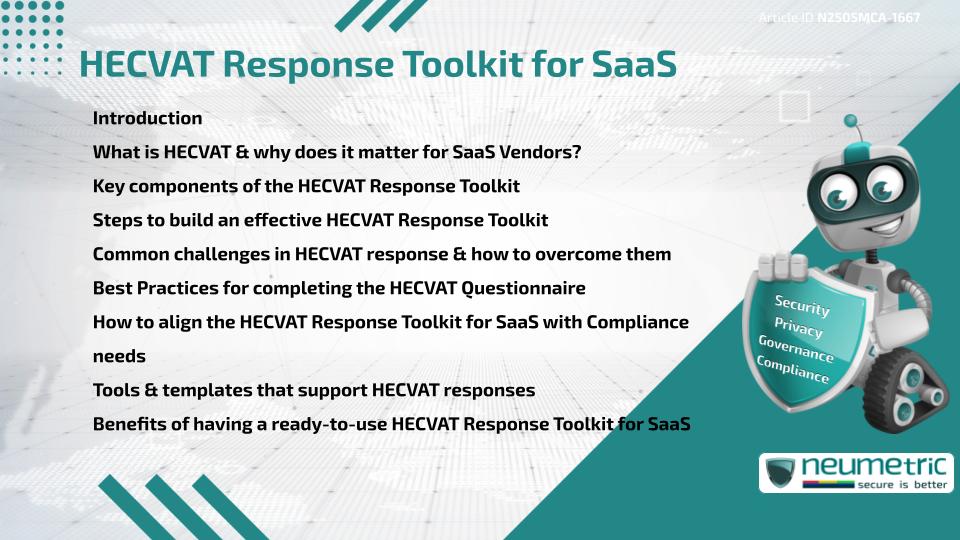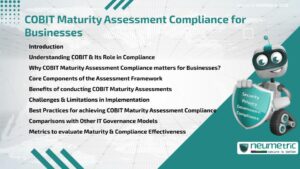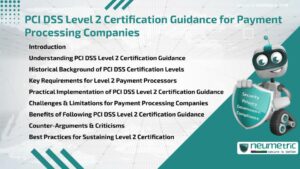Table of Contents
ToggleIntroduction
The Higher Education Community Vendor Assessment Tool [HECVAT] was created to help Colleges & Universities evaluate the security of Cloud Services. As more Institutions rely on Third Party Software, Software-as-a-Service [SaaS] Providers are expected to demonstrate strong Security Practices through the HECVAT Questionnaire.
A well-prepared HECVAT Response Toolkit for SaaS helps Vendors respond quickly & consistently to Security Assessments. It saves time, reduces errors & improves credibility with University Clients. This article discusses how to develop, maintain & gain value from this Toolkit.
What is HECVAT & why does it matter for SaaS Vendors?
HECVAT is a standardised Security Questionnaire utilised by Higher Education Institutions to evaluate Third Party Services. Developed by EDUCAUSE & the Higher Education Information Security Council, it ensures Vendors meet baseline security requirements.
For SaaS Vendors, responding to HECVAT is often a condition for doing Business with Universities. Without a completed HECVAT, Vendors may lose out on key Contracts. The HECVAT Lite & HECVAT Full versions each serve different Vendor Risk profiles.
Key components of the HECVAT Response Toolkit
A comprehensive HECVAT Response Toolkit for SaaS should contain:
- A finalised master copy of the completed HECVAT Questionnaire (either Lite or Full version).
- A Version-control Log for Responses
- Supporting Policy Documents (e.g. Data Encryption, Access Control)
- References to Third Party Audit Reports (e.g. SOC 2, ISO 27001)
- Contact points for follow-up questions
Including these components helps maintain consistency & ensures readiness for any University inquiry.
Steps to build an effective HECVAT Response Toolkit
Start with the following basic steps:
- Download the current HECVAT Template from EDUCAUSE’s official site.
- Assign Ownership to a Team member familiar with Security & Compliance.
- Collect supporting evidence like Penetration Testing Reports or Data Retention Policies.
- Centralise documentation in a secure File-sharing Tool.
- Review & update regularly, ideally every six (6) months or after any Security Audit.
This Toolkit is a living resource, not a one-time task.
Common challenges in HECVAT response & how to overcome them
Many Vendors find the HECVAT process time-consuming. Some common issues include:
- Lack of documentation: Without written Policies, it is hard to answer Technical Questions.
- Misinterpretation of questions: Security Language can be confusing without proper context.
- Unclear roles: If no single person is responsible, responses may be delayed.
To overcome these, SaaS Companies should document Internal Processes & appoint a Compliance Lead. A useful guide on writing Security Documentation can help improve response accuracy.
Best Practices for completing the HECVAT Questionnaire
When responding to HECVAT, consider the following tips:
- Be clear & concise in responses—avoid long Technical Explanations.
- Ensure responses reflect current practices—avoid including aspirational statements.
- Refer to Audit results where possible.
- Leave no blanks—use “N/A” when something does not apply.
- Use consistent terminology across the document.
Vendors should also avoid “security washing” by Overstating Controls, which can lead to Reputational Harm later.
How to align the HECVAT Response Toolkit for SaaS with Compliance needs
Most Universities expect Vendors to meet minimum Compliance Requirements. This often includes:
- Data Privacy (aligned with FERPA)
- Incident Response Readiness
- Vendor Risk Management
- Secure Data Transmission & Storage
To align your HECVAT Response Toolkit for SaaS with these expectations, Map responses to Controls in Frameworks such as NIST SP 800-171 or ISO 27001. This shows alignment with Global Security Standards.
Tools & templates that support HECVAT responses
Several Tools can support the HECVAT process:
- Spreadsheet software for Form filling (Excel or Google Sheets)
- Policy management platforms like Confluence or SharePoint
- Security Compliance tools like Drata or Vanta (for linking evidence)
- PDF editors for formatting final submissions
Templates should be stored in a Version-controlled location with restricted access to ensure Integrity & Confidentiality.
Benefits of having a ready-to-use HECVAT Response Toolkit for SaaS
With a structured HECVAT Response Toolkit for SaaS, Vendors gain:
- Faster onboarding with University Clients
- Improved trust & transparency in Vendor relationships
- Reduced workload for repeated responses
- Better internal alignment across Security, Sales & Legal Teams
- Improved Audit preparedness
These benefits translate into higher success rates in RFPs & Security Reviews.
Takeaways
- HECVAT is essential for SaaS Vendors working with Universities.
- A complete Toolkit improves consistency, saves time & builds trust.
- Align Toolkit responses with known Standards & Frameworks.
- Address common challenges through Documentation & Ownership.
- Tools & Templates reduce response friction & error.
FAQ
What is the purpose of a HECVAT Response Toolkit for SaaS?
It helps SaaS Vendors efficiently answer University Security Questionnaires by compiling all relevant Responses, Documents & supporting Evidence.
How often should the HECVAT Response Toolkit for SaaS be updated?
It should be reviewed & updated every six (6) months or after a major Security Event or Audit.
Do all Universities use the same HECVAT version?
No. Some prefer the HECVAT Full version while others may accept the Lite version depending on the Service Risk Level.
Can a Third Party help build a HECVAT Response Toolkit for SaaS?
Yes, several Security Consultants & Compliance Tools can assist with Documentation, Response strategy & Validation.
What are the most important documents to include in the HECVAT Response Toolkit for SaaS?
Policies on Data Protection, Access Controls, Encryption, Incident Response & any Third Party Audit Certifications.
Is a SOC 2 report sufficient to meet the requirements of a HECVAT review?
Not always. A SOC 2 Report helps but the HECVAT asks specific questions that may require additional Explanation or Documentation.
Can Startups use a HECVAT Response Toolkit for SaaS?
Yes & it can actually boost credibility with Academic Institutions by showing readiness to meet Compliance needs.
Are there penalties for incorrect HECVAT answers?
While not Legal Penalties, False answers can lead to Disqualification, Reputational Harm or Contract Termination.
What should be done if a question in the HECVAT is not applicable?
You can mark it as “N/A” but ensure you provide an explanation if required by the reviewing Institution.
Need help?
Neumetric provides organisations the necessary help to achieve their Cybersecurity, Compliance, Governance, Privacy, Certifications & Pentesting goals.
Organisations & Businesses, specifically those which provide SaaS & AI Solutions, usually need a Cybersecurity Partner for meeting & maintaining the ongoing Security & Privacy needs & requirements of their Clients & Customers.
SOC 2, ISO 27001, ISO 42001, NIST, HIPAA, HECVAT, EU GDPR are some of the Frameworks that are served by Fusion – a centralised, automated, AI-enabled SaaS Solution created & managed by Neumetric.
Reach out to us!





